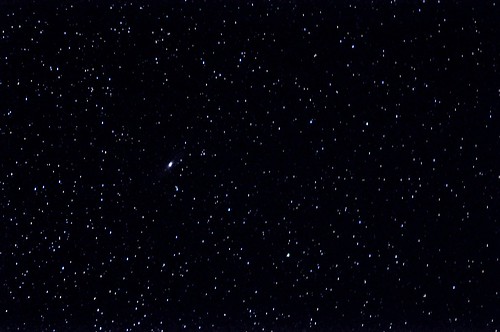But the overwhelming real reason?

I wanted to take long exposure shots of the night sky. This is the early evening sky over the Ionian sea last week. Since we're still in the Northern Hemisphere it's familar enough to be recognizable, but the shift eastwards from Canada means that, night after night, I still find it difficult to orientate myself with Orion on the eastern horizon instead of directly overhead. Luckily I am attending the sort of field school that gives you cushy rooms in studio apartments instead of having you kip in the bush. Because, you know what? Going to the bathroom at 3am while camping does require some knowledge of north-south-east-west in order to allow you find your way back to your sleeping bag instead of heading off in the wrong direction into God knows what.

In Kananaskis, "God knows what" could mean cougars or bears. Here in Kefalonia it would mostly mean goats. Lots of goats. I haven't taken zooarchaeology (animal bones) yet but damned if I cannot identify goat poop and goat teeth and goat long bones now, because there were plenty on site. Both goat bones and live goats, I mean. You would pull up a nice great big nasty goat molar out of some poor man's pithos grave, and look up and see a slot-eyed goat staring down at you from further up the hill. Goats? Kind of mean, and smelly, and loud. Goat herding dogs? Incredibly lazy - they would come to the site and lie around and get belly scratches from the students instead of doing their job, until the goat herder would come over the hill crest and find his herd scattered everywhere.

But we've actually been done the excavation work for a month now, because tomorrow is actually our last full day here before we all get on the ferry back to Athens. Wait, what? Over already? And I've barely posted anything in November at all. That is because of lab work. Oh, lab work. I do love it - the bones, at least. Catalouging pottery is something else entirely, however. It is really satisfying to pull something out of the ground that you know no one else has handled for 2500 years, and then to take it back to the lab and gently wash off all the dirt and goat poop, and find something underneath it all. It's just that I mostly found prehistoric coarseware which, after the 400th shard, gets a little monotonous.
There have been some really spectacular pieces, however, and if this wasn't an unpublished excavation I would totally show you pictures. Really, I would. A beautiful ribbed votive offering pot, still completely intact - and its little cousin, same shape and style, only smaller than your closed fist. Our complete burials turned up amber beads and a silver ring in one, and a nearly complete black and red Attic vessel in the other, with a maenid and a satyr painted on it and everything. Cool, cool stuff.
But I still like the bones the best. Next door to our lab area in the municipality building there is another group of archaeologists doing work on the Tzanata Mycenaean tholos tomb. Tzanata is close to Poros, about a 20 minute walk. A tholos tomb is a beehive shaped mausoleum sort of deal that, surprise surprise, the Mycenaeans were partial to. The Tzanata one is the biggest found in Western Greece and is quite nicely intact. The Google pictures I've linked to are mostly from a tholos tomb by Nestor's palace near Olympia on the mainland, and it's a reconstruction (it's also really moldy inside. Ew.).
Mycenaens are a big deal because they were the ones who were in Greece before the classical Greeks (as we think of them) were, and if the Odyssey and the Iliad were based on somewhat real events and people, they would have been Mycenaean.
Odysseus is always from Ithaca in the books and stories. Modern day Ithaca, the island of Ithaki, is right by Kefalonia - they're closer to each other than Vancouver Island and Horseshoe Bay are. Makis and Hettie, the lovely couple who've done a lot of stuff for our program, have worked (along with their archaeologist children) on some papers arguing that Kefalonia is actually the kingdom of Odysseus. Kefalonia matches the geographical descriptions of Odysseus' kingdom better than Ithaki does and no one's found anything Mycenaen in Ithaki yet. They make a pretty good arguement about it, but the Greeks take their sagas damned seriously and the suggestion that Ithaki isn't really Ithaca has caused some political issues, so shh! Keep the story I'm going to tell you on the down low.
Yesterday the Tzanata archaeologists let us take a look at (and even handle, woohoo!) the skull from the oldest grave in the Tzanata tomb. The Tzanata tholos was a little odd in that, instead of setting the sarcophagi on the floor of the tomb, a bunch of graves were actually found dug below the ground level of the tomb. The skull was beautifully intact, from a guy who was above thirty years old. And his teeth? Immaculate. Better than mine. Basically that says royalty. But, theoretically, if Odysseus was a real dude, and his kingdom was actually in Kefalonia, and he got a sweet tholos tomb for himself and his descendants...the skull could have concievably been Odysseus' skull.
I think that is the coolest thing ever, and it is why I love bones.
Okay, okay, it's a huge stretch, and of course it wasn't Odysseus. But I still think it's cool to hold someone's skull in your hands and be able to say something about who they were because of the size of their mastoid process and the how fused their cranial sutures are and how nice their teeth are.

No comments:
Post a Comment